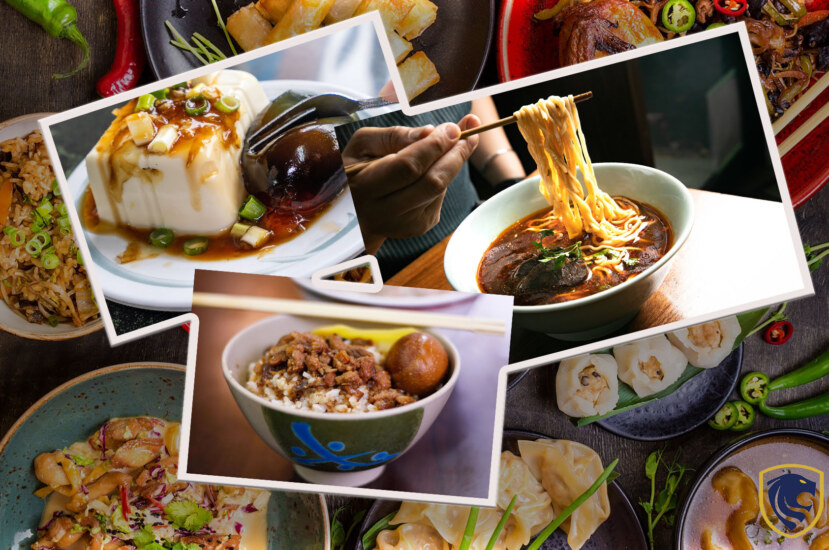According to many food loves Taiwanese food is the most underrated food in the world. Because they have a set of amazing food that can make anyone have a taste shock. Taiwanese cuisine has a little Chinese hint to it.
Ah-gei
Tamsui in New Taipei City is famous for its Ah-gei. If you ever have got a chance to spend a day there, you must have gone out of your way to get this Taiwanese cuisine. Ah-gei, one of the most popular dishes in the Tamsui District, is a fried tofu skin filled with noodle soup and sealed with surimi, a type of seaweed commonly found in Japan. The Original Ah-Gei store was created in 1965. Also, they’ve followed the same recipe ever since. They are still regarded by many as the greatest and most genuine. In addition, what makes them so special is that they cook the stuffed tofu in a stewed ground pig which adds even greater flavor to the dish. They also blend surimi with a mixture of surimi and carrots.

Ah-gei
Beef Noodle Soup
It’s difficult to imagine any one country can lay claim to the simple pairing of gently cooked meat and a tangle of slurpable noodles. Although it has Chinese roots, it is nevertheless regarded as Taiwan’s national cuisine. Also, it has been given a uniquely Taiwanese twist with the inclusion of pickled mustard greens. Moreover, a distinctive five-spice powder with the flavors of star anise, cloves, Chinese cinnamon, Sichuan pepper, and fennel seeds is added to the dish to enhance its flavor. Every year, Taiwan plays home to the Taipei International Beef Noodle Festival. There, gallons of the substantial soup, made with beef bones and slow-simmered for days, are devoured.

Beef Noodle Soup
Even within 7-Eleven stores throughout the island, Lay’s sells a Red Braised Beef Noodle Soup with potato chip flavor. Every restaurant has a unique, closely-guarded secret recipe with differences in the broth. Also, the size of the noodles and the caliber of the meat varies from place to place. One restaurant in Taipei costs an outrageous TWD 10,000 (USD 325) for a bowl in the United States and Australia. However, the majority of Taiwanese have a favorite local restaurant. There a bowl of beef noodle soup typically costs no more than TWD 185 (USD 6).
Gua Bao
Many tourists are eager to sample the finest Gua Bao burger because of all the buzz around it. Most foodies recommend going to Lan Jia in Taipei.
Tender braised pork belly is sandwiched between steamed bao buns to make gua bao, commonly known as pork belly buns or Taiwanese hamburgers. You may decide how fatty you want the pork to be or go with half and half like I did.

Gua Bao
Because the pork belly is so beautifully soft and supple, It appears that the Taiwanese have a talent for preparing meat! Since soy sauce and sesame oil are common components in Asian cuisine, it has a fairly pronounced Asian flavor.
Chòudòufu
Chudufu is often known as smelly tofu. It is a fermented tofu that differs by area and vendor. Typically, it is created by bringing and frying raw tofu. In addition to being fried, this variety of tofu may also be eaten cold, steamed, and stewed. It has a crispy exterior and a buttery inside after being fried. In addition to the rice, it is often served with soy sauce and chiles as well. In the beginning, it may take a few days to get used to the scent and taste of this food, particularly for those who are trying it for the first time. But this is true of other fermented foods from throughout the world. The Shilin Night Market in Taipei is one of the greatest venues to taste this delicacy.

Chòudòufu
Coffin bread
Coffin toast, also known as coffin bread, is one of the strangest foods to eat in Taiwan.
The only odd thing about it is the name. Coffin toast is a deep-fried sandwich with meaty curry that may be calorie-dense but still tasty. You’ll notice the similarities if you’ve ever had rabbit chow in South Africa. However, some argue that this is even less nutritious because the sandwich is deep-fried.

Coffin bread
Visit Dongdaemun Night Market in Hualien, Taiwan’s east coast, and look for the vendor with the long line in the back left corner. He will treat you with the most delicious coffin bread in the world.
ZongZi
When compared to more current favorites like bubble tea, Zongzi feels far more traditional and emblematic of older, true Taiwanese food. It is easy to understand the history of these sticky rice dumplings. Because they are also a classic Chinese delicacy.

ZongZi
Steamed or boiling rice is used to make zongzi, which is then filled with either sweet or savory ingredients including tapioca, taro, red bean paste, eggs, pork, or chicken. After that, bamboo leaves are used to keep them together.
You won’t get bored trying different kinds of zongzi. Because there are so many types to choose from! They are typically sold in street food markets and eaten as a full snack.
Baobing
Yes, this pile of lovely golden mangoes was just as delightful as it appeared to be. A popular dessert in Taiwan is barbing, which is made from condensed milk and topped with a variety of toppings, such as fruit, ice cream, taro, azuki beans, pieces of sweet potato, peanuts, and grass jelly. Mango is one of the most common tastes in Taiwan due to the high quality of their produce.

Baobing
Traditional Taiwanese Mango barbing is excellent at Kaohsiung’s Gao Xiong Po Po Shaved Ice. There are mango syrups, mango ice creams, and fist-sized chunks of delicious mango that taste like nectar on top of the mango syrups. According to tourists, it is really tasty and sweet from nature!
Braised Pork Rice
This is perhaps second only to beef noodle soup in popularity among comfort meals in Taiwan. Until it is fall-apart tender, the minced pork belly in this Taiwanese delicacy is cooked slowly and stir-fried in soy sauce. The dish is then placed on top of a serving of steaming rice. Also, it is frequently accompanied by a side of hardboiled eggs that have also been cooked in the soy sauce combination.

Braised Pork Rice
Rice lovers choose lu rou fan over beef noodle soup. According to Taiwanese food lovers, this dish is outstanding. The pieces of pork belly are so soft that they virtually dissolve in your tongue and are served with a rich sauce that is sweet and flavorful. I could imagine myself eating this warm Taiwanese meal every day.
Ba wan
Taiwanese mega-dumplings are called ba wan. The interior is filled with pork, vegetables, and occasionally eggs. A delicious gravy is then added on top. It is often served on sidewalks and at evening markets and can be steamed or fried.

Ba wan
The dough for ba wan, a disk-shaped chewy dumpling, is composed of rice flour, corn starch, and sweet potato starch. When cooked, the dough takes on a faintly translucent appearance. Bamboo shoots, shiitake mushrooms, and soft pig flesh are combined with red yeast to create a flavorful meatball filling. When the dumpling is served, it is divided into bite-sized pieces and covered in rich gravy or a sticky, sweet sauce.




